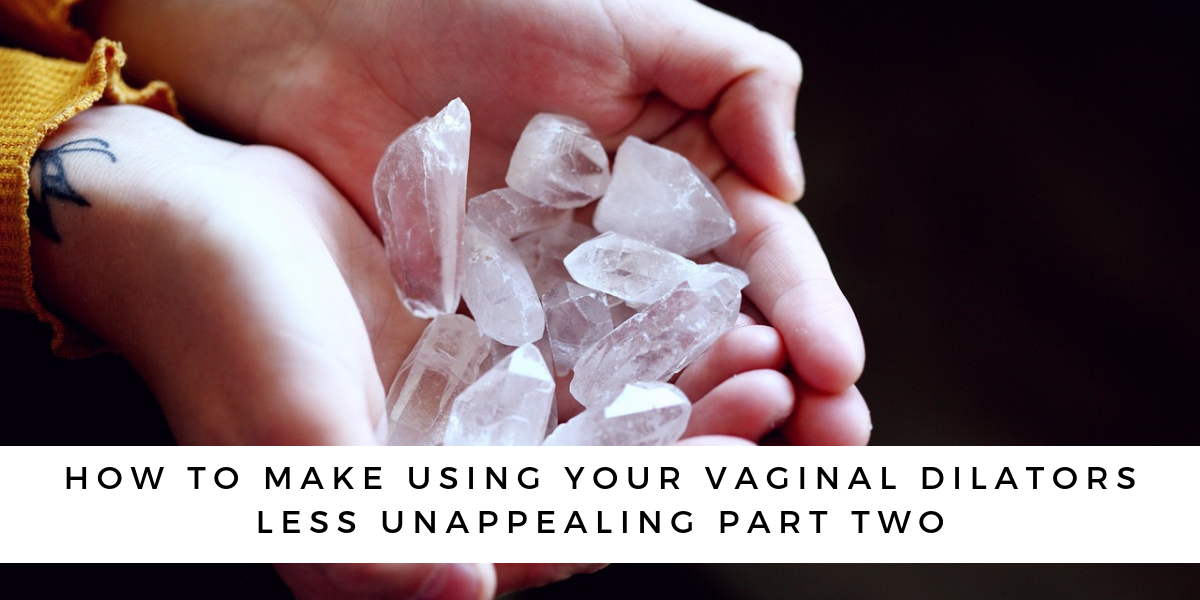Get Acquainted With Them
In vaginismus and painful sex, using vaginal dilators is often part of your rehab program.
Let’s face it, anything unfamiliar can be a bit scary. A new experience is always a bit daunting, even when it’s positive. And it makes sense from an evolutionary sense to be cautious when encountering a new object, even if it ends up being good for you.
It’s natural to feel some trepidation about starting work with your vaginal dilators.
As it is, you’re probably feeling a bit nervous or anxious already. You have been experiencing difficulty using tampons and possibly painful sex, and your super smart brain is working overtime to warn you of any other possible dangers out there.
(It’s great to have the ultra-developed brain of a human being, which learns from experience and tries to look out for you. But this is one situation where you’re going to have to convince your brain you’re in no danger of harm, and that trying something new – using vaginal dilators – is actually going to help you.)
I’ve already talked about how naming your vaginal dilators can help. Another important step in convincing your brain that using dilators is actually ok is to get acquainted with them.
Get to know your dilators! Get a bit more familiar with them!
This uses a concept known among psychologists and pain therapists as “graded exposure”.
Graded exposure is the opposite of throwing yourself in the deep end. It’s just dipping your toe in the water, realising that the water is a bit cold but won’t kill you, and gradually dipping more and more of your body in. This way, you get used to it. You don’t think you can do it when you start, but you take small steps to give you confidence.
What are some things you can do to get acquainted with dilators?
One of the best things you can do to get to know any object is just to hold it.
When you are just using your eyes, your brain works overtime in dreaming up all kinds of intimidating thoughts. If you use your other senses, such as touch, it takes away that sense of a “foreign object”.
So take out your dilator kit, and hold them one at a time. Start with the smallest. Feel how smooth it is. Feel its temperature.
Place it against the skin of your arm to get a sense of how it feels to the body.
You can do this as gradually as you like. You may want to keep the bigger ones hidden away for a while if they are psyching you out. There is no reason you need to store all the dilators together. You can even start by just keeping the small one somewhere you see it, like your underwear drawer, so that your brain gets lots of “incidental exposure”.
There is research showing that if you have seen a stranger before – without realising – when you next see them you unconsciously rate them as more friendly. I can’t see why dilators would be any different! The more you see them, the less scary they will be.
Even more powerful would be to store them with something appealing, unexpected or humorous.
You could store your dilator in your sock drawer, in a zany sock or a lacy stocking. This will automatically make your brain have more positive associations with it.
You could use it as a jewellery or ring stand on your dresser.
You could keep them with your knitting needles. (Even casting on a few stitches to them while they’re waiting to be used, in your favourite colour yarn).
Or even in a bowl of fake fruit on your dresser!
These suggestions might sound silly, but that’s exactly why they work. They shock the brain into a different mode and remove the “threat” associated with the dilators. In pain science, this is called “homuncular refreshment”. It’s a legitimate technique!
So think like the experts.
Start yourself on some graded exposure to dilators, using homuncular refreshment!
More about graded exposure in the next instalment. In the meantime, you might want to refresh your memory on some other cute ideas of getting used to your vaginal dilators in my first post in this series.
GENERAL ENQUIRIES
(07) 3277 0226
(07) 3277 0216
- 12 Edna St,
Salisbury Queensland 4107
Autralia

